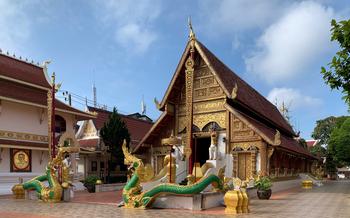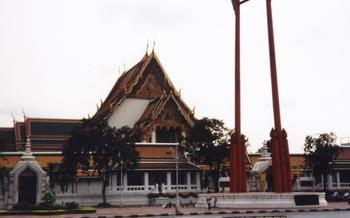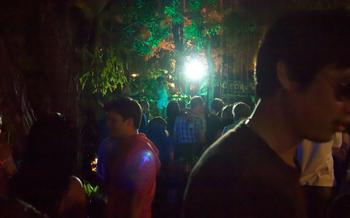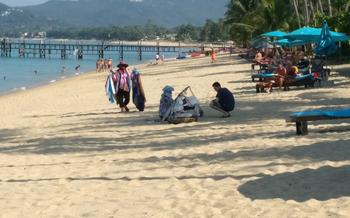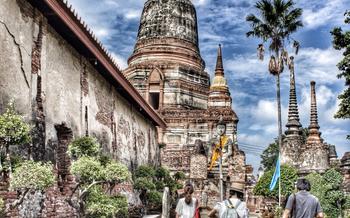
Wat Salak Petch Temple
- The Wat Salak Petch Temple: A Spiritual Haven
- Location and Accessibility
- Visiting Hours and Admission Fees
- Exploring the Temple Grounds
- Paying Respect to Buddha Images
- Admiration the Temple's Architecture
- Immerse Yourself in Wat Salak Petch's History
- Join Temple Festivals and Ceremonies
- Learn About Thai Buddhism
- Volunteer Opportunities
- Local Cuisine and Dining Options
- Shopping for Souvenirs
- Health and Safety Precautions
- Photography and Social Media Etiquette
- Insider Tip: Hidden Gems and Secret Spots
The Wat Salak Petch Temple: A Spiritual Haven
The Wat Salak Petch Temple, also known as the Temple of a Hundred Pinnacles, is a magnificent Buddhist temple located on the island of Ko Chang in Thailand. It is a popular destination for both locals and tourists seeking spiritual fulfillment, cultural immersion, and architectural appreciation.
The temple's history dates back to the 18th century when it was founded by a revered monk named Luang Phor Yim. According to local legends, Luang Phor Yim possessed supernatural powers and was able to perform miracles, which drew many followers to the temple. Over the years, the temple has undergone several renovations and expansions, but it has retained its original charm and spiritual significance.
Architecturally, the Wat Salak Petch Temple is a stunning example of traditional Thai temple design. The temple complex features intricate carvings, colorful murals, and a series of towering stupas, or Buddhist spires, that give the temple its distinctive name. The main prayer hall houses a large Buddha image, surrounded by smaller Buddha images and other religious artifacts.
The temple is a place of active worship, and visitors can often observe monks chanting prayers or performing religious ceremonies. Several festivals and events are held throughout the year, including the annual temple fair and the Visakha Bucha Day celebration, which commemorates the birth, enlightenment, and passing of Buddha.
When visiting the Wat Salak Petch Temple, it is important to dress respectfully and observe proper temple etiquette. Visitors should remove their shoes before entering the temple grounds and refrain from touching or pointing at Buddha images. It is also customary to make a small donation to the temple to support its upkeep and maintenance.
Location and Accessibility
The Wat Salak Petch temple is conveniently situated in the heart of Ko Chang, making it easily accessible for visitors. It is nestled in the tranquil village of Salak Petch, approximately 10 kilometers from the main tourist hub of White Sand Beach. To reach the temple, visitors can opt for various transportation options. Those who prefer a scenic journey can take a leisurely boat ride from White Sand Beach to the Salak Petch Pier, followed by a short walk to the temple. Alternatively, a more direct route involves renting a motorbike or hiring a taxi from White Sand Beach, which takes around 20 minutes.
For those driving, ample parking space is available within the temple grounds, ensuring a hassle-free visit. Additionally, the temple is wheelchair accessible, allowing visitors with disabilities to explore the premises comfortably.
Visiting Hours and Admission Fees
Wat Salak Petch welcomes visitors throughout the week, offering an opportunity for spiritual exploration and cultural immersion. The temple's opening hours are typically from 8:00 AM to 5:00 PM, allowing ample time for visitors to explore the grounds, immerse themselves in the serene atmosphere, and participate in religious ceremonies or festivals.
Admission to the temple is free of charge, making it accessible to all. However, donations are gratefully accepted and serve as a valuable source of support for the temple's upkeep and maintenance. For those seeking a deeper understanding of the temple's history, culture, and significance, guided tours are available upon request. Knowledgeable tour guides are available to provide insights into the temple's architecture, religious practices, and local traditions, enhancing the overall experience for visitors.
Exploring the Temple Grounds
Wat Salak Petch temple complex is a treasure trove of architectural wonders and sacred sites. As you step through its gates, you'll be greeted by a serene courtyard adorned with meticulously landscaped gardens and towering trees. The temple's layout is designed to promote a sense of tranquility and spiritual connection.
At the heart of the temple, the grand ubosot (ordination hall) stands as a testament to the temple's grandeur. Its intricate carvings, glistening spires, and vibrant murals depict scenes from Buddhist mythology and history. Inside, the ubosot houses the temple's most sacred Buddha image, Phra Buddha Maha Mongkol, a revered object of devotion for both monks and laypeople.
Beyond the ubosot, you'll find a cluster of smaller shrines and stupas, each dedicated to a different aspect of Buddhism. Explore the viharn (assembly hall), where monks gather for prayers and meditation. Visit the chedi (stupa), a symbolic representation of the Buddha's teachings, and pay homage to the relics of revered monks enshrined within.
As you wander through the temple grounds, keep an eye out for the intricate carvings and sculptures that adorn every corner. These exquisite works of art depict mythical creatures, celestial beings, and scenes from the Buddha's life. Each carving tells a story, inviting you to delve deeper into the rich tapestry of Thai Buddhist culture.
Take your time to explore the temple's serene gardens, where colorful flowers, lush greenery, and trickling fountains create a peaceful and harmonious atmosphere. Find a quiet spot to sit and meditate, or simply soak in the tranquil ambiance of this sacred space.
Paying Respect to Buddha Images
In Thai culture, Buddha images are highly revered and hold immense spiritual significance. Visitors to Wat Salak Petch are expected to show respect and observe proper etiquette when interacting with these sacred objects.
When entering the temple, it is customary to remove your shoes and leave them in the designated area. Once inside, you will see several Buddha images enshrined in various locations throughout the temple complex.
To pay respect to a Buddha image, you can perform a wai, which is a traditional Thai greeting. Stand in front of the image with your hands pressed together in a prayer-like position, slightly below your chin. Bow your head slightly and say a silent prayer or chant.
You can also make offerings to the Buddha images as a way of showing your devotion and gratitude. Common offerings include flowers, incense sticks, and candles. These can be purchased from the temple's donation counter or from local vendors outside the temple.
When placing your offerings, do so in a respectful manner. Place the flowers gently at the base of the Buddha image, light the incense sticks and candles, and then step back to allow others to pay their respects.
Remember to always maintain a respectful demeanor and avoid touching or climbing on the Buddha images. These sacred objects are revered by the Thai people and should be treated with the utmost care and respect.
Admiration the Temple's Architecture
The Wat Salak Petch Temple showcases a unique architectural style that blends traditional Thai elements with contemporary design. Its most striking feature is the stunning ubosot, or ordination hall, which is adorned with intricate carvings, colorful murals, and gleaming golden stupas. The roof of the ubosot is a masterpiece in itself, featuring a multi-tiered design with elaborate bargeboards and finials that reach towards the sky. Every corner of the temple is adorned with intricate details, from the delicate lotus motifs on the pillars to the mythical creatures guarding the entrance. The overall effect is one of grandeur and serenity, inviting visitors to marvel at the craftsmanship and devotion that went into its creation.
Immerse Yourself in Wat Salak Petch's History
Wat Salak Petch is steeped in a rich and fascinating history, with its origins dating back to the early 19th century. According to local lore, the temple was founded by a revered monk named Luang Pu Salak, who was renowned for his spiritual wisdom and healing powers.
Legend has it that Luang Pu Salak possessed a magical stone that could heal the sick and bring good fortune. He used this stone to cure numerous villagers, earning their respect and admiration. In gratitude, the villagers built a small temple to honor Luang Pu Salak and his miraculous stone. Over time, the temple grew in size and prominence, becoming the spiritual center of the local community.
Throughout its history, Wat Salak Petch has played a significant role in the lives of the people of Ko Chang. It has served as a place of worship, a center for community gatherings, and a source of education and guidance. The temple has also been a refuge for those seeking peace and solace, and a place where people can come to connect with their spirituality.
Join Temple Festivals and Ceremonies
Wat Salak Petch is not just a place of worship; it's also a vibrant community hub where traditional Thai festivals and ceremonies are celebrated throughout the year. These events offer visitors a unique opportunity to immerse themselves in the rich cultural heritage of Thailand and witness the devotion of the local people.
The most significant festival held at the temple is the Songkran Festival, also known as the Water Festival. This annual event takes place in April and marks the Thai New Year. During Songkran, the temple grounds transform into a lively scene of water fights, music, and dancing. Visitors are encouraged to join in the festivities, donning colorful clothes and playfully splashing water on one another as a symbol of cleansing and renewal.
Other notable festivals celebrated at Wat Salak Petch include Visakha Bucha, which commemorates the birth, enlightenment, and passing of Buddha, and Makha Bucha, which honors the unity of the Buddhist community. These festivals are marked by special ceremonies, chanting, and offerings made to Buddha images. Visitors are welcome to observe these ceremonies and gain a deeper understanding of Buddhist traditions.
Participating in temple festivals is a fantastic way to interact with the local community, experience the vibrant Thai culture firsthand, and create lasting memories of your visit to Ko Chang.
Learn About Thai Buddhism
Wat Salak Petch is not just a place of worship; it also serves as a center for learning and practicing Thai Buddhism. Visitors can gain insights into the basic teachings and principles of Buddhism, which emphasize compassion, mindfulness, and the pursuit of enlightenment. The temple's monks are knowledgeable and welcoming, and they are happy to share their wisdom with visitors who are interested in learning more about Buddhism.
Meditation and mindfulness practices are an integral part of Thai Buddhism, and visitors to Wat Salak Petch can participate in meditation sessions or learn about mindfulness techniques. These practices can help to reduce stress, improve focus, and cultivate a sense of inner peace and well-being.
Volunteer Opportunities
The Wat Salak Petch temple is actively involved in various community projects that aim to give back and support the local community. Visitors who are passionate about giving back and immersing themselves in local culture can explore volunteer opportunities at the temple.
One of the primary ways to volunteer is by assisting with the temple's educational initiatives. Visitors can help teach English to local children, organize workshops on Buddhist teachings, or lead meditation sessions for the community. These programs provide a unique opportunity to share knowledge and skills while fostering cross-cultural understanding.
Additionally, the temple welcomes volunteers to assist with temple maintenance and upkeep. Tasks may include gardening, cleaning, or helping with renovations and construction projects. By contributing to the physical upkeep of the temple, visitors can directly support the preservation of this sacred space.
Volunteering at Wat Salak Petch is a rewarding experience that allows visitors to make a positive impact on the local community while learning more about Thai culture and Buddhism. The temple provides a warm and welcoming environment where volunteers can connect with locals, share their skills, and gain valuable insights into Thai society.
Local Cuisine and Dining Options
While exploring the temple grounds, visitors can satisfy their hunger with the delectable offerings of local food stalls and restaurants situated nearby. These culinary havens serve an array of traditional Thai dishes, each bursting with authentic flavors. From fragrant curries and spicy stir-fries to refreshing salads and sweet desserts, the options are endless.
For a truly immersive experience, visitors can indulge in the local favorite, pad thai, a stir-fried rice noodle dish with a harmonious blend of tangy, sweet, and savory flavors. Another must-try is tom yum goon, a spicy and sour soup with succulent shrimp, mushrooms, and aromatic herbs.
For those seeking vegetarian or vegan options, the temple area also offers a variety of delicious choices. From tofu-based curries to fresh fruit salads, there is something to satisfy every palate.
When dining at local eateries, visitors are encouraged to embrace the local custom of bargaining. This friendly negotiation not only allows for a good deal but also fosters a sense of connection with the vendors.
By sampling the local cuisine, visitors can not only satisfy their hunger but also gain a deeper appreciation for Thai culinary traditions and culture.
Shopping for Souvenirs
As you wander through the temple grounds, you'll come across several stalls selling religious artifacts, amulets, and souvenirs. These items are not only beautiful keepsakes but also a way to support the temple and its ongoing projects.
From intricately carved Buddha images to protective amulets and traditional Thai handicrafts, you'll find a wide variety of items to choose from. Whether you're looking for a gift for a loved one or a memento of your visit, you're sure to find something special here.
When shopping at the temple, remember to be respectful and mindful of local customs. Bargaining is acceptable, but do so politely and with a smile. The vendors are often happy to share stories about the items they're selling, so don't hesitate to ask questions and engage in conversation.
By purchasing souvenirs from the temple, you're not only taking home a piece of Thailand but also contributing to the preservation and maintenance of this sacred site. So, take your time, browse the stalls, and find a unique souvenir that will remind you of your spiritual journey at Wat Salak Petch.
Health and Safety Precautions
When visiting Wat Salak Petch Temple, it is essential to be mindful of local customs and traditions to ensure a respectful and enjoyable experience. Visitors should dress appropriately, covering their shoulders and knees, and avoid wearing revealing or overly casual clothing. It is customary to remove shoes before entering the temple's inner sanctum, and visitors should do so quietly and respectfully.
The temple is a sacred place, and visitors should maintain a respectful demeanor, avoiding loud noises, boisterous behavior, or running around. It is also essential to be mindful of the privacy of monks and other visitors, refraining from taking photos of them without their permission.
To ensure a safe and comfortable visit, visitors should take necessary health and safety precautions. The temple is located in a tropical climate, so it is advisable to wear light, breathable clothing and protect oneself from the sun with sunscreen, sunglasses, and a hat. Staying hydrated is essential, especially during the hot and humid months. Insect repellent can also be useful to ward off mosquitoes and other insects.
Photography and Social Media Etiquette
While capturing the beauty of Wat Salak Petch through photography is encouraged, it's essential to be mindful of the temple's sacred nature and the privacy of its visitors. Respect the designated areas for photography and avoid taking pictures of monks or other visitors without their consent. Use a flash only when necessary, as it can be disruptive during ceremonies or meditation sessions.
When sharing your photos on social media, be mindful of the context and captions you use. Avoid making disrespectful or insensitive comments, and ensure that your posts promote cultural understanding and appreciation. Tag the temple's official social media accounts to give them credit for the beautiful images you share.
Remember, the temple is a place of worship and reflection. Silence your phone and refrain from loud conversations or disruptive behavior. Be respectful of the tranquility of the environment and allow others to enjoy their visit in peace.
Insider Tip: Hidden Gems and Secret Spots
Beyond the main temple buildings, explore the lesser-known areas of Wat Salak Petch to discover hidden gems waiting to be unveiled. Seek out the tranquil gardens nestled amidst serene surroundings, where you can find secluded spots for meditation and reflection. Escape the crowds and wander along the peaceful walkways that lead to hidden corners of the temple complex, offering unique perspectives and a sense of tranquility.
For an unforgettable experience, climb the secluded staircase to uncover a secret viewpoint that reveals breathtaking panoramas of the surrounding landscape. From this hidden vantage point, soak in the beauty of Ko Chang's lush greenery, the sparkling blue waters, and the distant mountain ranges. Capture breathtaking photos that will serve as cherished memories of your visit.

